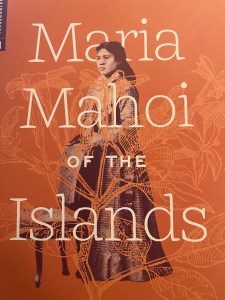
Despite previous visits to nearby Vancouver and Victoria, this May we happily toured the Gulf Islands for the first time. Choosing Pender and Salt Spring, the archipelago is tucked in the Salish Sea between Vancouver Island and the mainland of British Columbia. A ‘googling’ of the Gulf Islands tells you that they’re home to ‘eclectic residents with bohemian souls.’ That may be the case and you’ll meet a few of them – along with so called every-day people who desire a simpler life – yet what strikes you is the soulful beauty, the gentle living and deep sense of community. On Pender Island, the eclectic Fridge Culture was the real unexpected delight. On Salt Springs, it was the idyllic paddling to other smaller islands… so very magical with intriguing historical stories to reveal.



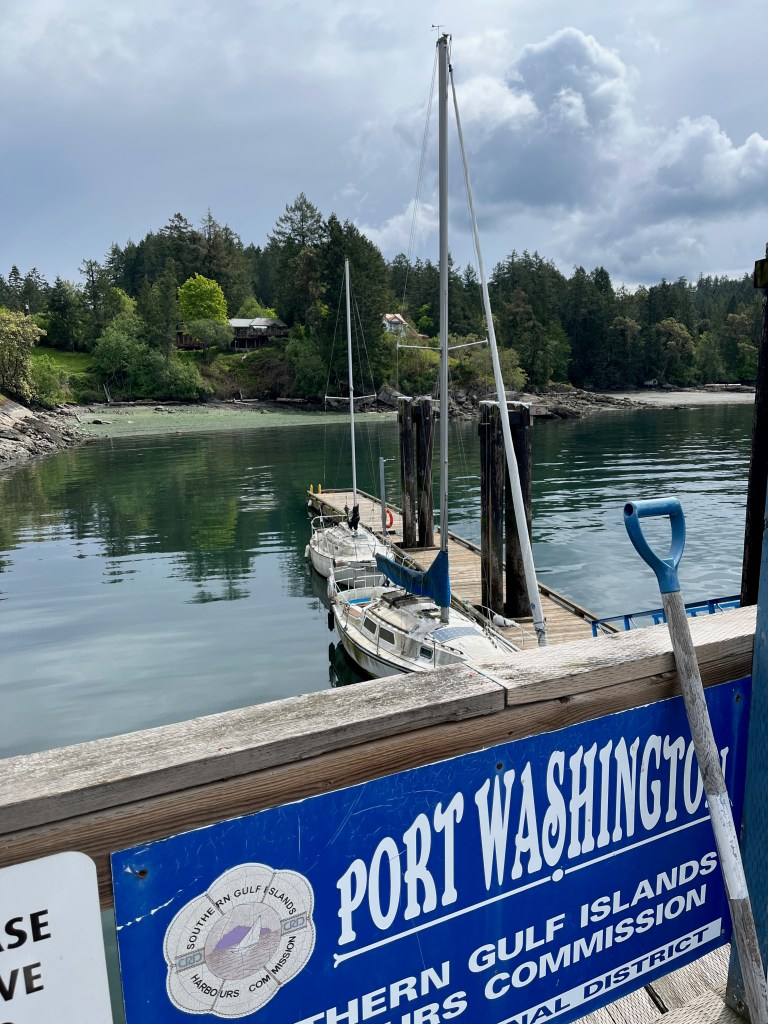


Pender Island
We embark on the ferry at Tsawwassen, just outside of Vancouver, and we’re instantly transported to vistas of sheltered coves and deep inlets, to craggy treelined coastlines and pristine sparkling waters. It’s breathtaking as we ripple through the waters and although we don’t happen to spot the star of the show, the mighty orca, eagles glide and soar high above beckoning us into their slice of paradise. After stops at Galiano and Mayne, our ferry docks into Otter Bay on Pender Island. The name Gulf Islands derives from the Gulf of Georgia, the original term used by Captain George Vancouver in his mapping of the islands for the British Crown. These days, the islands are accessible by small harbours operated through the Southern Gulf Islands Harbours Service. Not only are the harbours charming, they’re an important part of island life; points of access for inter-island travel, for school boats and marine ambulances, for Canada Post and utility services. Some of the ports are more care-worn than others such as the seemingly once-busy The Shed at Port Washington, contrasted with the local hangout of HUB Restaurant and Hope Bay Store at the Hope Bay Harbour. Whichever distinct character each harbour may take on, all are monitored by a wharfinger… the all-important keeper of the wharf.
Away from the harbours and coves, the inland vibe of Pender Island doesn’t take long to reveal itself. It’s picturesque, and hilly. Roads line with ancient cedars, ferns and mustard-yellow broom cascade all around. And just when you’re feeling hemmed in by the trees, open farmland and fields emerge where you just might find pigs nestled in mud and tractors tilling the land. Vibrant blooms infuse the still-chilly springtime air as we happily meander. In no time at all, you will have traversed both North and South Pender. We come across the island’s handy Car Stops, an alternative to hitch hiking, where a chair or bench is placed for your comfort as you wait for a ride from an accommodating islander. We’re told it’s not only a veritable link of transport, but also a conduit for gossip in these parts!




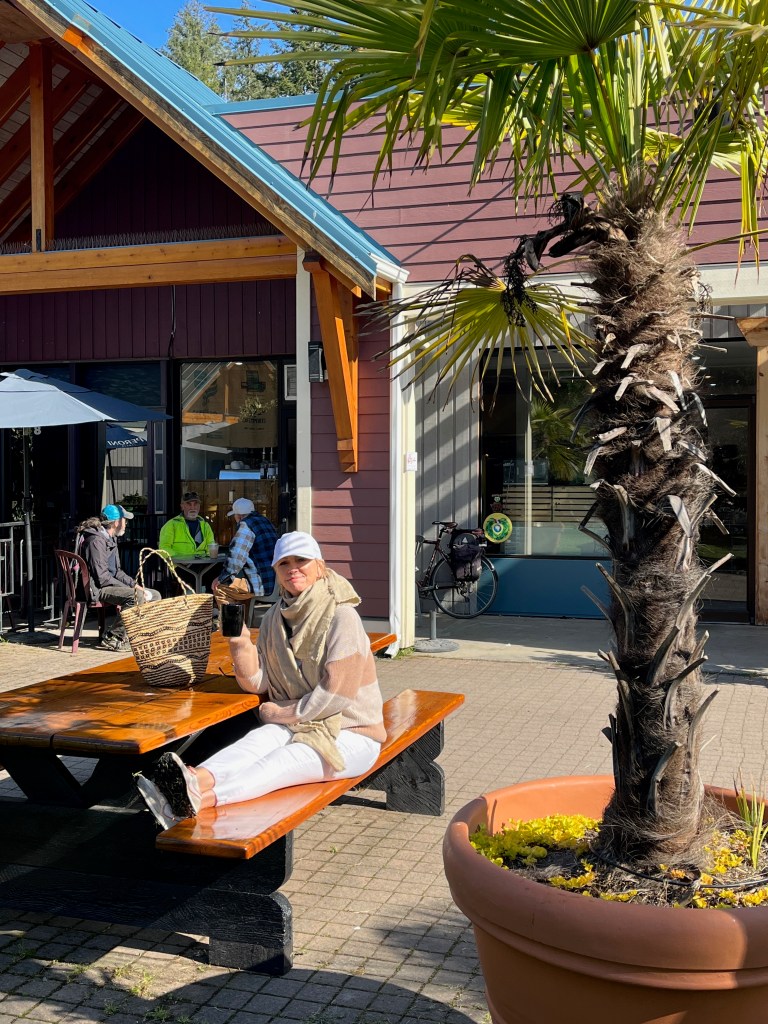

Pender Island – rich in hunting, fishing and gathering – has been inhabited by the Coast Salish people for thousands of years and still today is home to members of the Tsawout and Tseycum First Nations. The Spanish arrived in 1791, charting the islands and bestowing them with names like Saturna, Valdez, and Galiano. Daniel Pender, aboard the HMS Plumper, surveyed the coast from the end of the 1850’s through to the 1870’s. Permanent colony settlers arrived about that time from the British Isles, The US, Hawaii and Japan…. the sub-Mediterranean climate was certainly part of the appeal.

We don’t stay at the busy tourist and wedding venue hot-spot, Poets Cove, but somewhere a little more authentic and close to the heart of the island’s main town square, the Driftwood Center. The Driftwood is a busy hive of palm trees sprouting in terracotta pots, picnic tables hosting conversations and the whafting of good coffee. Just down the road and perched on a hill overlooking the pristine bay at Port Browning Harbour is Nosy Point B & B, our home away from home for a few nights. After having been relocated from the city years ago, this is the Victorian-style home’s new location. Left to neglect, then rescued and refurbished, the ‘grand old dame’ was slowly brought back to life. We meet its owner and B & B host Stephen on the first evening. We’ve returned from the nearby Browning Pub just as he’s pruning flowers and a dogwood tree that needs some special attention. We hear about the ‘grand dame’ and how it acquired its name – literally a once nosy neighbour – and our conversation happily meanders to all things on Pender, before settling on our mutual travels in India. I’m again reminded of why I love staying in smaller, more intimate places.
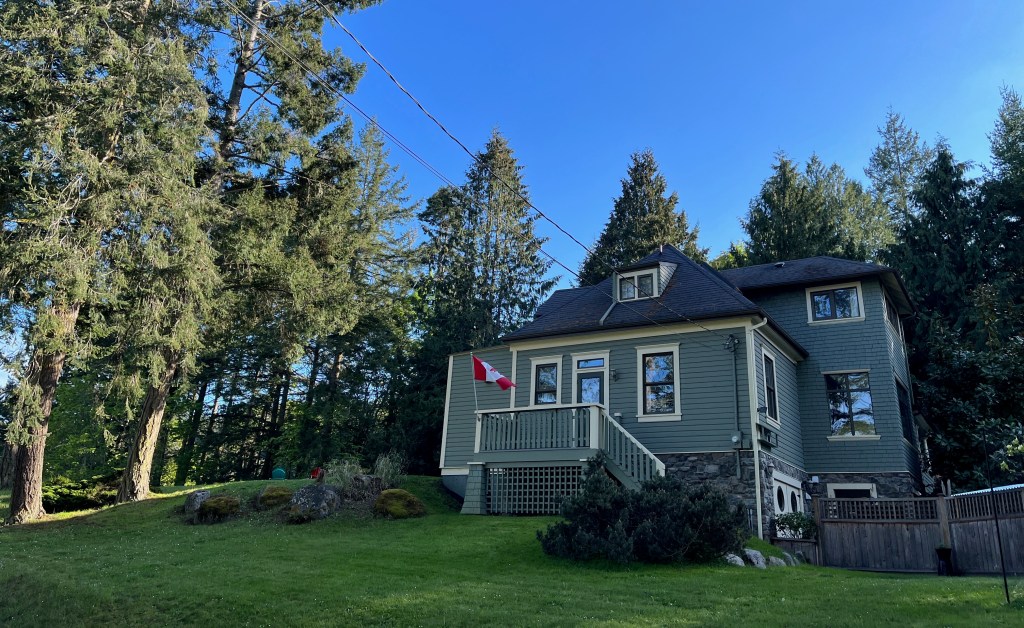


As I settle into an Adirondack chair for a glass of wine, the evening sun illuminates the boats nestled on the bay of marine blues and misty greys. The cedars are towering and resplendent as their willowy branches embrace the space, like tendrils between the past and the present – a reminder of the Salish peoples here for thousands of years. I hear the plaintive calls of seagulls over the bay. I jot missives in my notebook. I smile as I gaze out at Bruce, away in the distance for an evening paddle… it’s a smile of a good, good day on Pender.
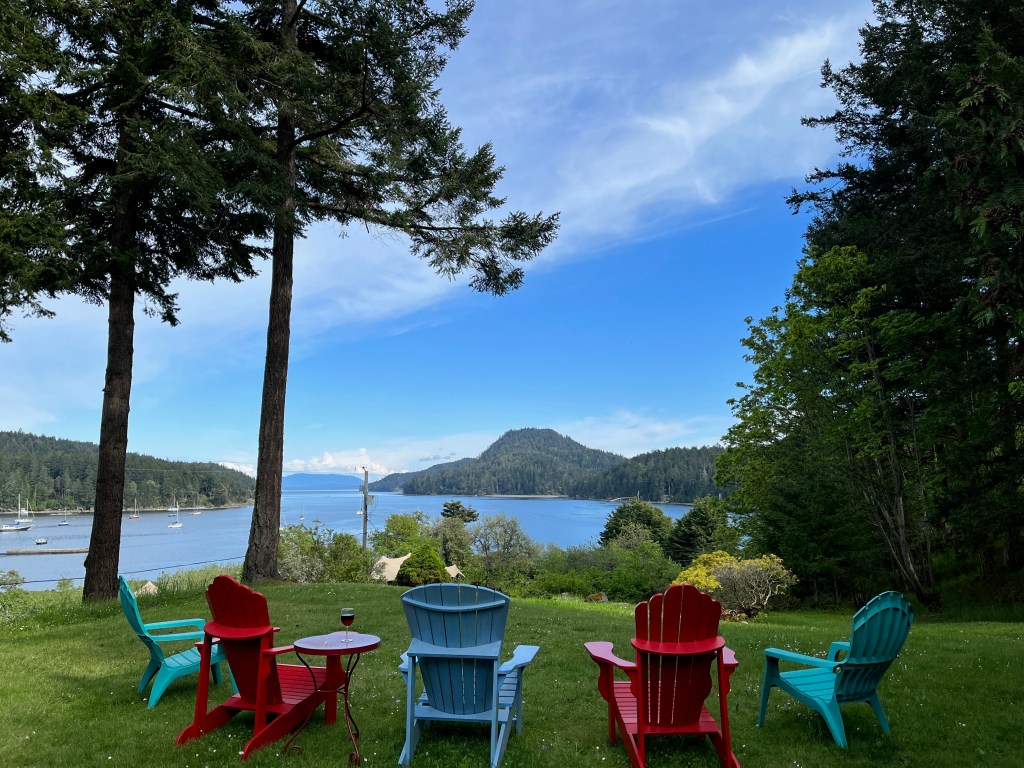
The next morning I wake up to the chitchat of Bruce, Stephen and another guest in the breakfast room. It’s early, yet I curl up in a dusty pink armchair in the corner of our Admiral Room. Plank wood floors, soft-grey shiplap walls, a variegated fig plant and a model ship decorate the room. It’s cozy and as the cedars sway outside, I muse on a conversation at the pub the previous night.
Gillian had served us, a transplant from Edmonton, a food & beverage enthusiast and sommelier, a lovely young lady whose dreams with her partner have come true on Pender. With pride and delight, Gillian informed us of the ‘must do’s’ and so I plot our course of discovery for the day… Amy’s Bread Shed, The Fridge of Wonders, The Cheesecake Fridge, The PeaShoot Fridge. And why not throw in Happy Hour at Poet’s Cove while you’re down that way!
And so we do as the locals suggest. Pull up to the roadside fridge or shed, select what we’d like, leave cash in the kitty on the honour system, enjoy produce and wondrous creations. Fresh bread and croissants from Amy’s were nibbled on throughout the day. Jars of delicious Turmeric Ginger Sauerkraut from the Fridge of Wonders was a success as gifts from the Islands. Unfortunately, the Cheesecake Fridge was bare when we arrived, but did we visit the Pea Shoot Fridge twice? Absolutely!


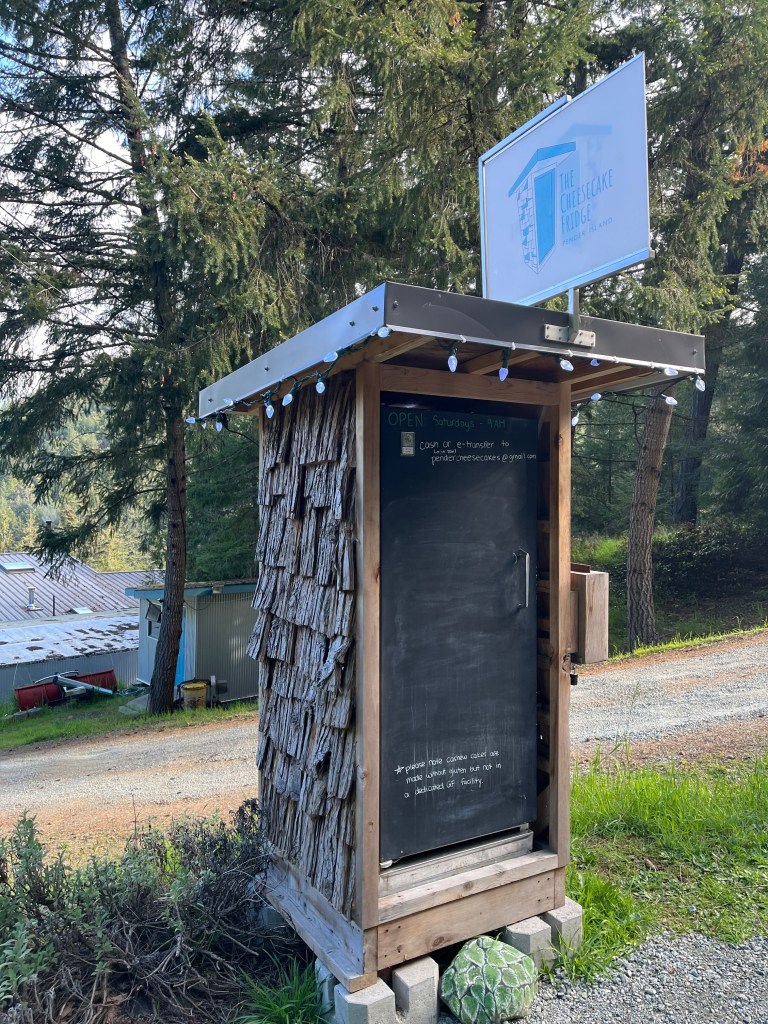
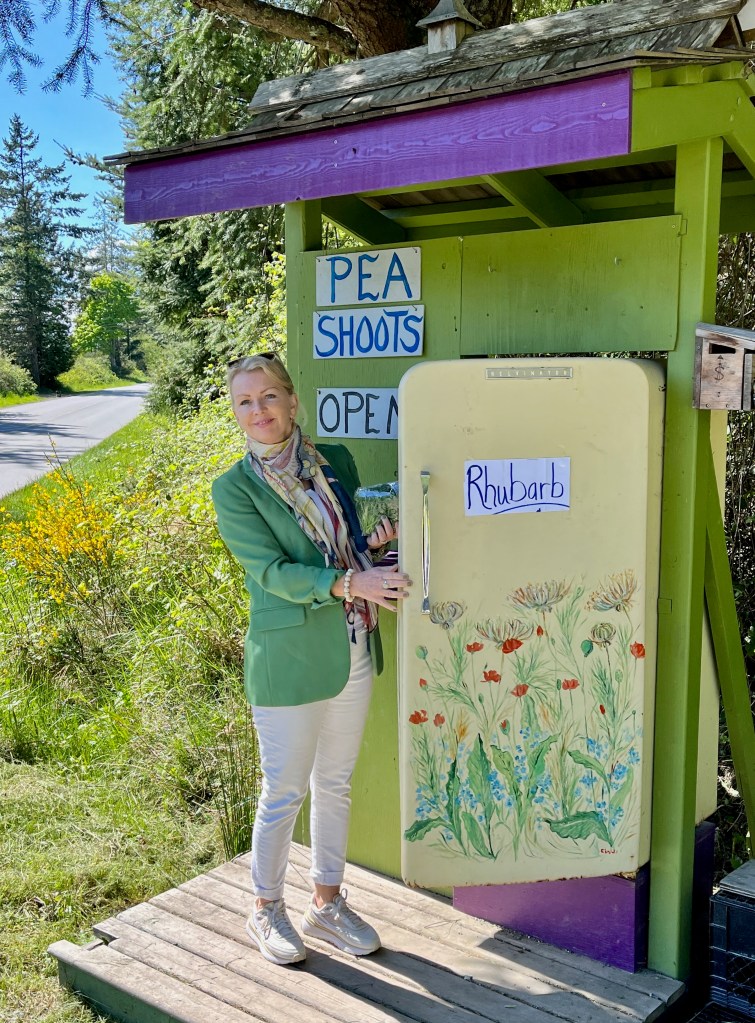


Salt Spring Island

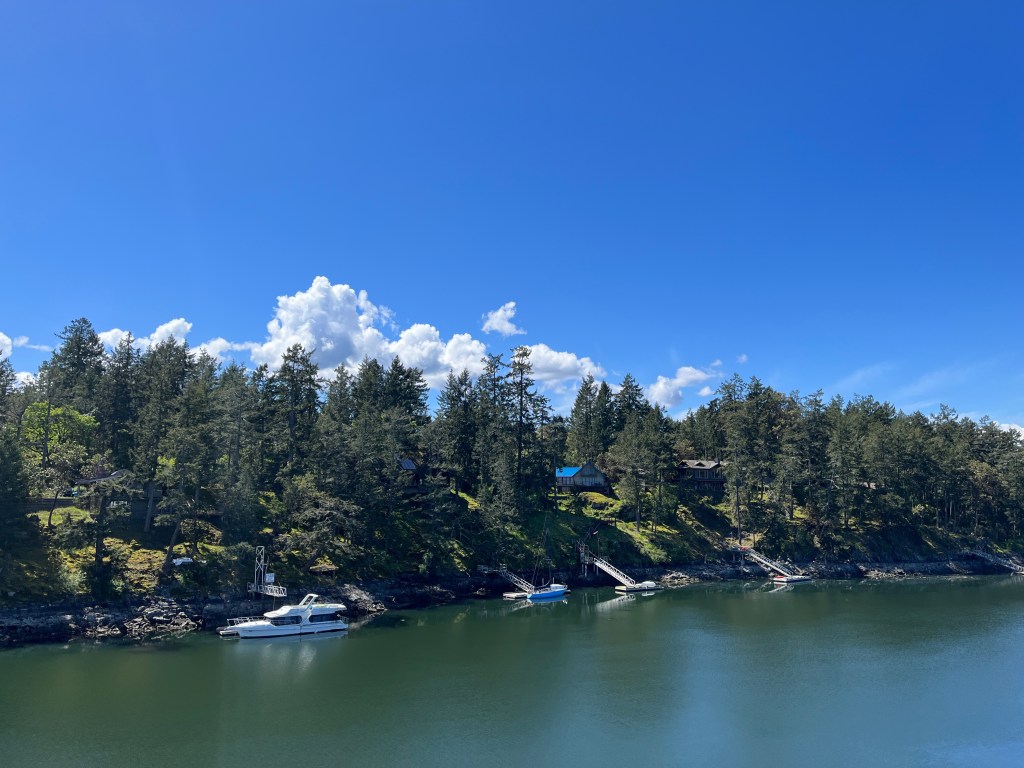

On day three we ferry to Long Harbour on Salt Spring, the largest most populous of the Gulf Islands. Its name is a nod to the island’s salt springs, yet our first stop is a wander through the quaint town of Ganges. There’s an artsy vibe with ample galleries and coffee shops serving the local Salt Spring Coffee brew. The plethora of artisans on the island is long-standing, the popular Saturday market the vibrant showcase for the hundreds of vendors who either, ‘Make it, bake it, or grow it.’
And as on Pender, there’s an emphasis on homegrown ‘farm to table’ or ‘Farm Stand Foraging’ the local tourism office tells us. As promised, leisurely driving or cycling around the island is a veritable shopping experience unto its own. Open air stands offer everything from eggs and flowers, to wood kindling and candles, to cheese and pottery. Also stop in at the wineries, Salt Spring Kitchen Co., or sample apple cider at one of the cider companies. Yes absolutely, the island is bursting with apples!
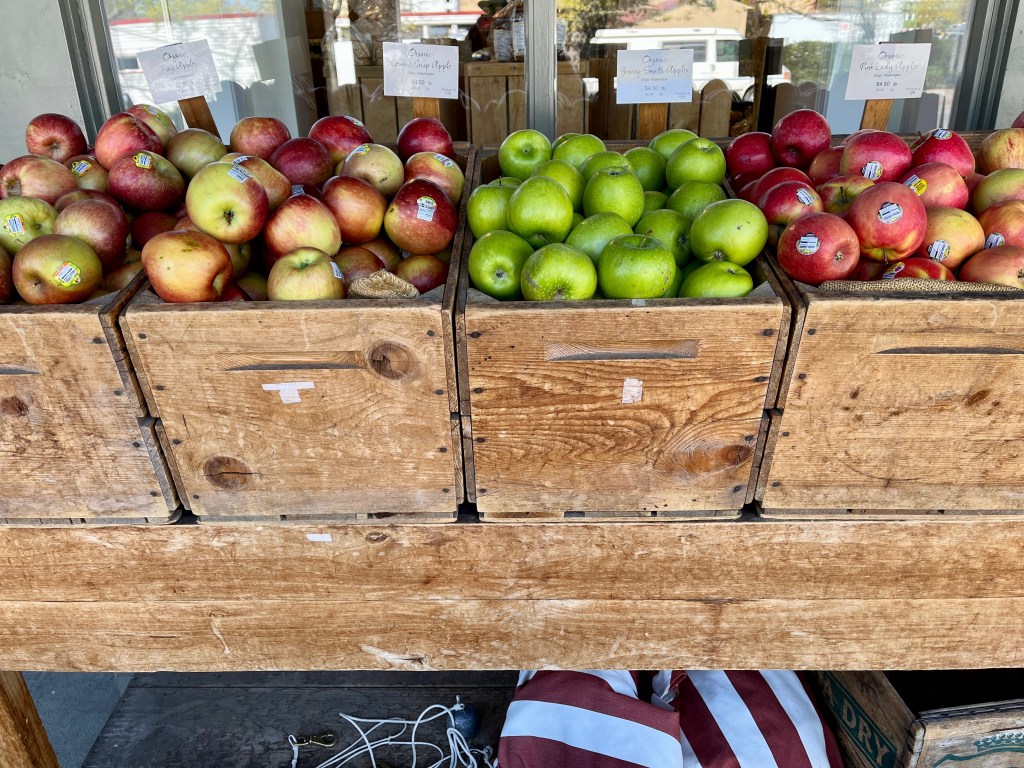
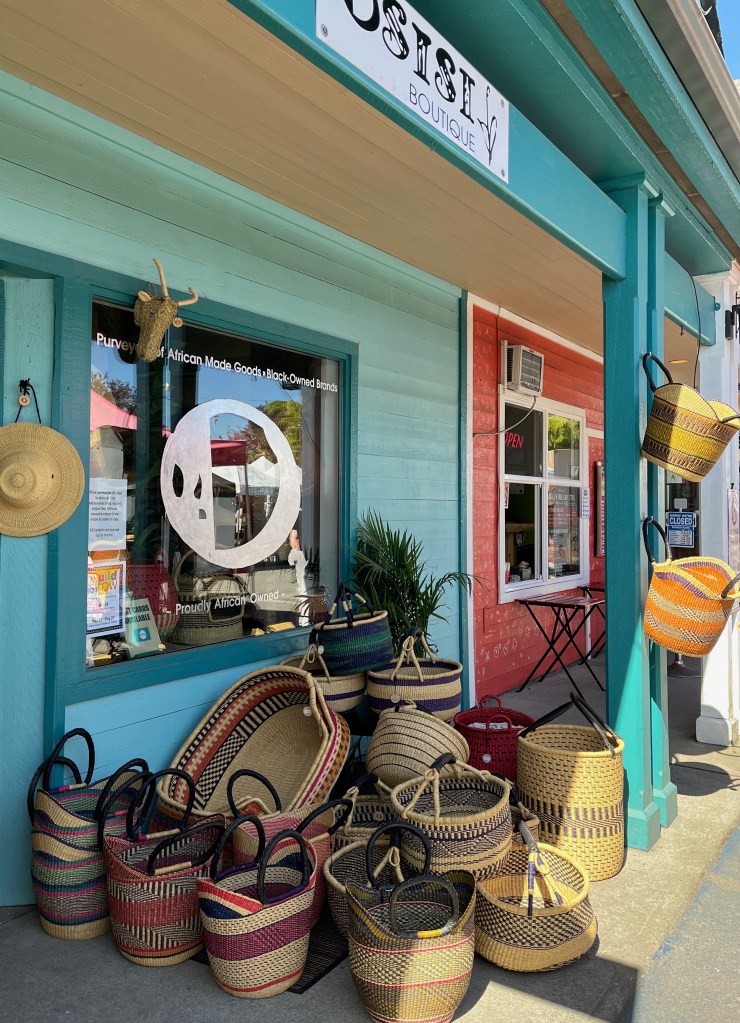

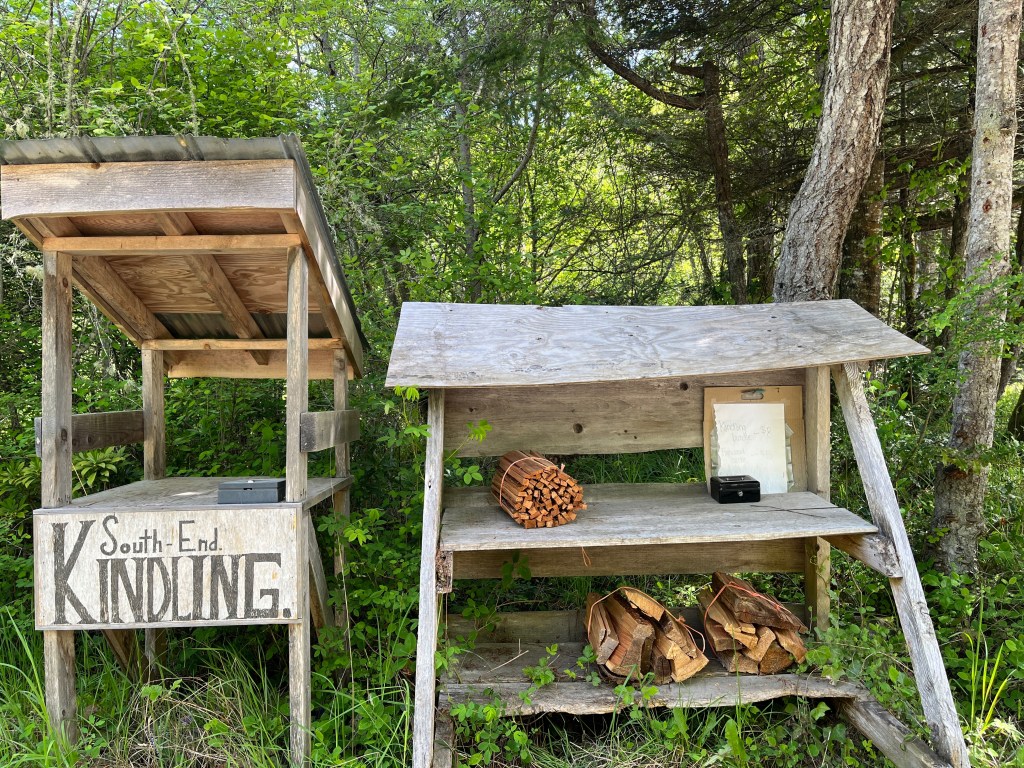
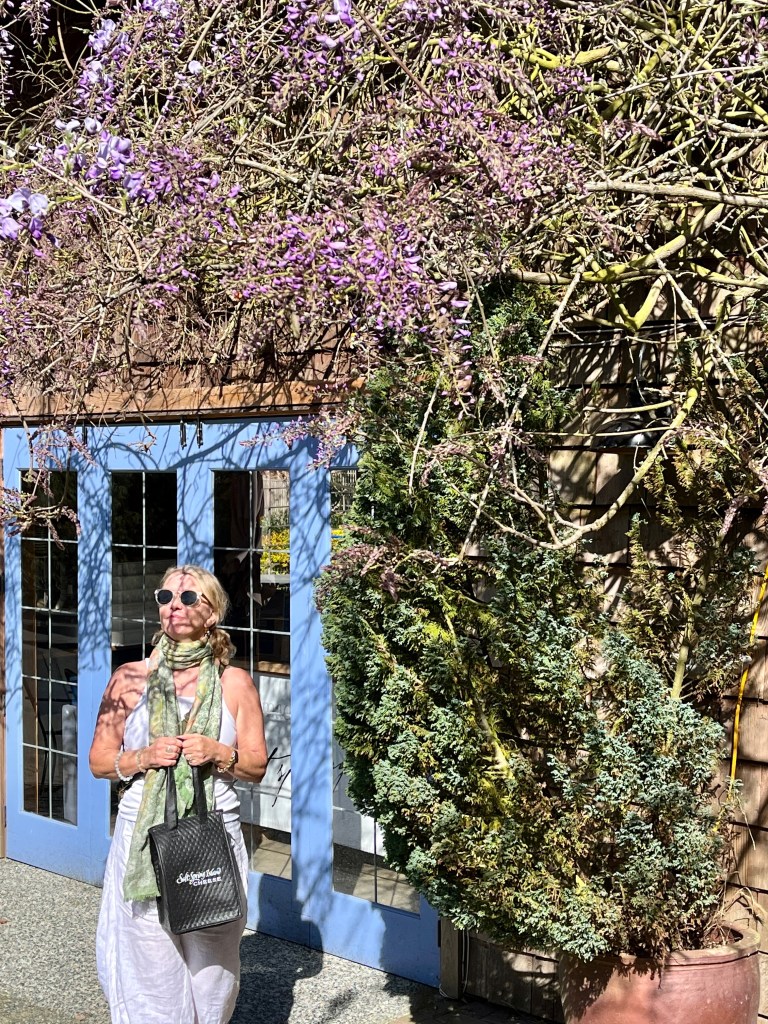

With some 450 varieties of apples grown on Salt Spring, traditionally they’ve been an important agricultural product. The island’s farming roots were integral to the settlers who arrived here on what was the homeland of the Salish people. During the Hudson Bay Company’s fur trading days, hundreds of Hawaiians worked for them as labourers, often choosing to settle once their contracts finished. The tropical paradise – relative to many other colder parts of the country – was an enticement, as was pre-emption. Up until the 1880’s, this process allowed settlers to acquire land if they cleared and improved the plot before purchasing it for the grand sum of $1. per acre. As settlers took advantage of pre-emption, Salt Spring quickly became a diverse community where farming was often supplemented with fishing and logging. African Americans also settled here, escaping discrimination at home and hoping for a better life. Today with a population of about 12,000, the rich and varied heritage of long-standing families blends with the newly settled – either permanently or those with vacation homes.
Admittedly, our main endeavour on Salt Spring is to paddle and it’s while we’re on the water that we savour the sheer beauty of our surroundings. From the kayak and on SUP’s, the shorelines take on their magical vistas – sprawling stands of shore pine, statuesque Douglas fir and crooked arbutus trees against backdrops of gentle hills. On the water we gaze into the curious eyes of otters as they glide past. In the piercing blue sky we follow the soar of eagles, and the constant paths of floatplanes. Coming into shore, we gaze down into forests of kelp beds, then beach comb ancient shell middens. On our second day of paddling, we venture to tiny Russell Island south of Fulford Harbour. It’s here that we become acquainted with one of those early island settlers, Maria Mahoi of Hawaiian and Indigenous descent.
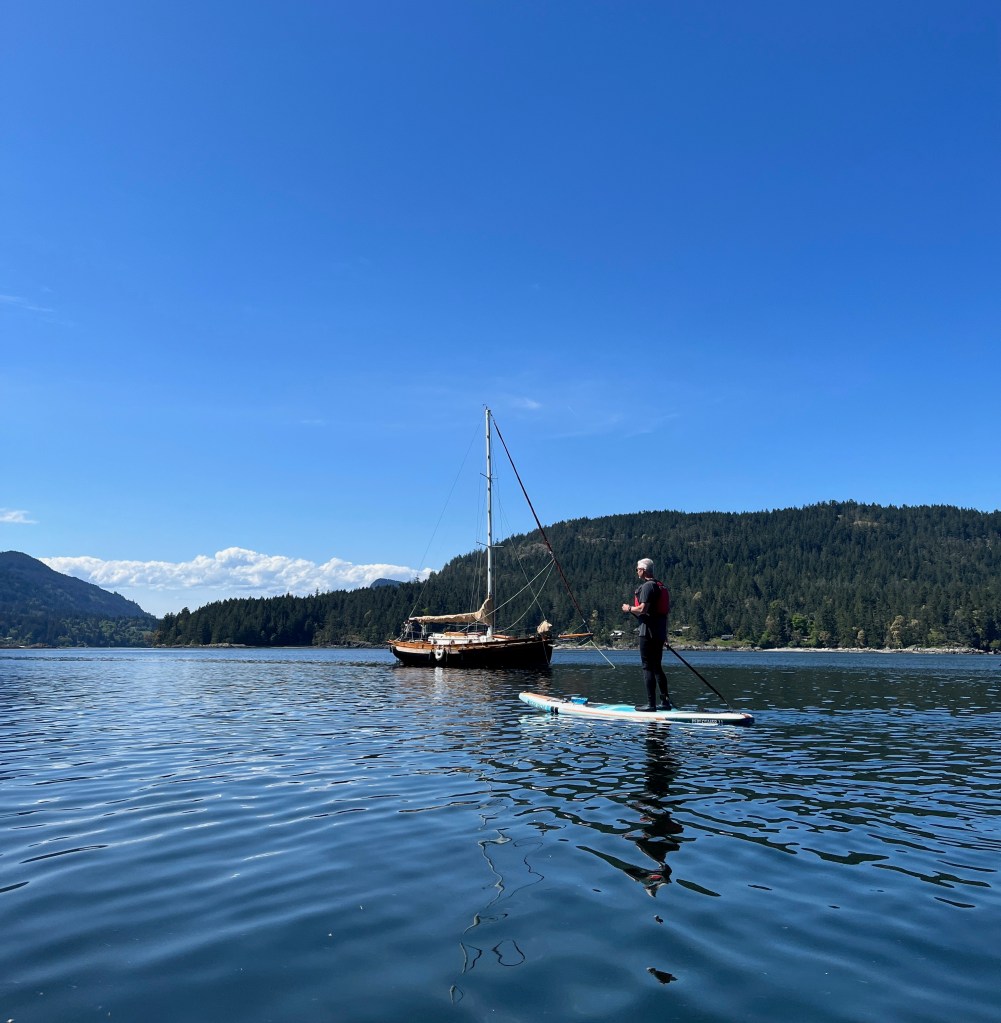
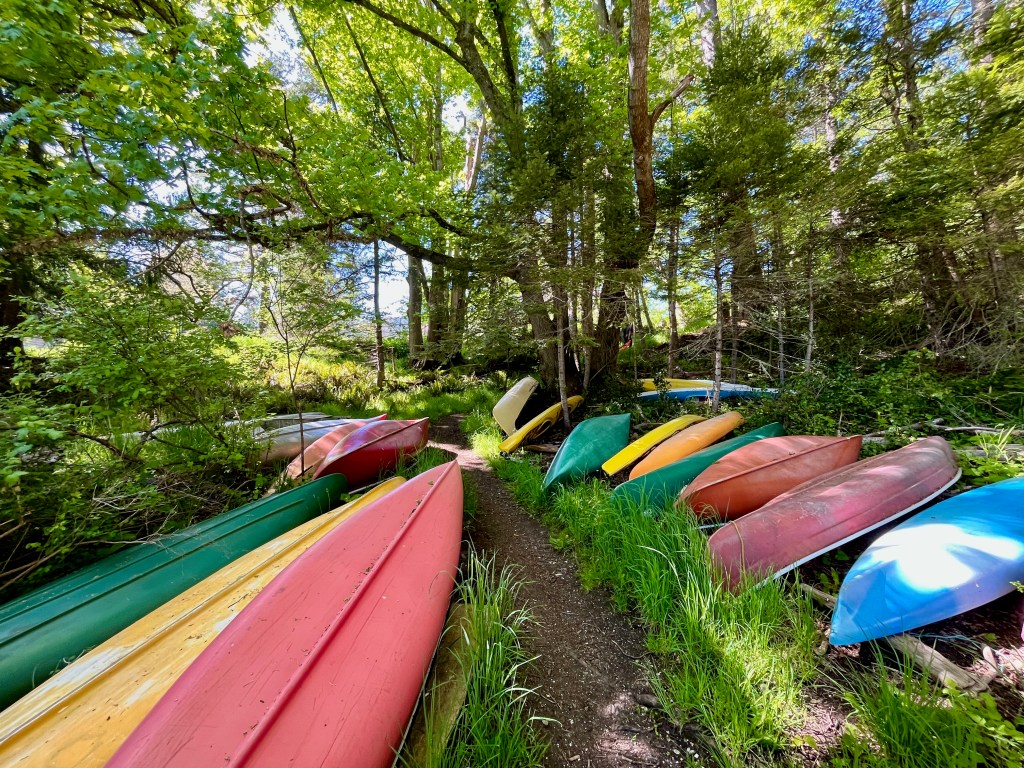
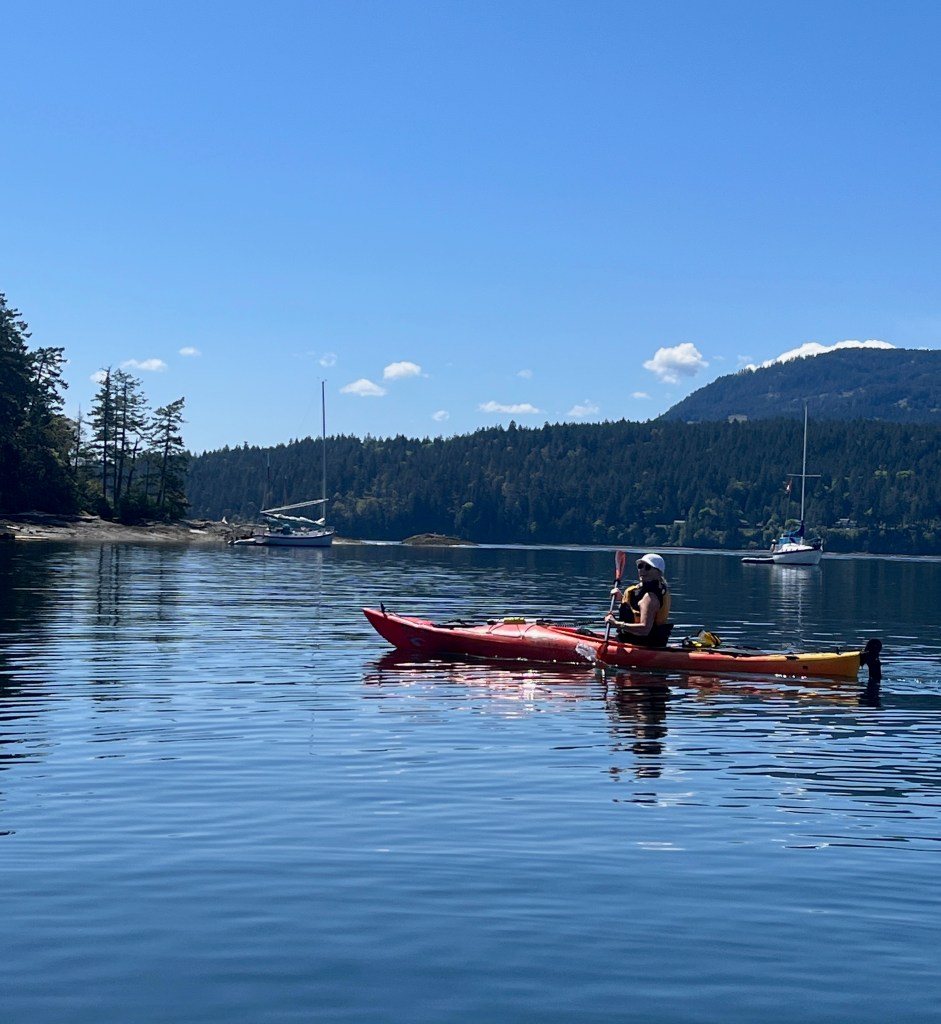
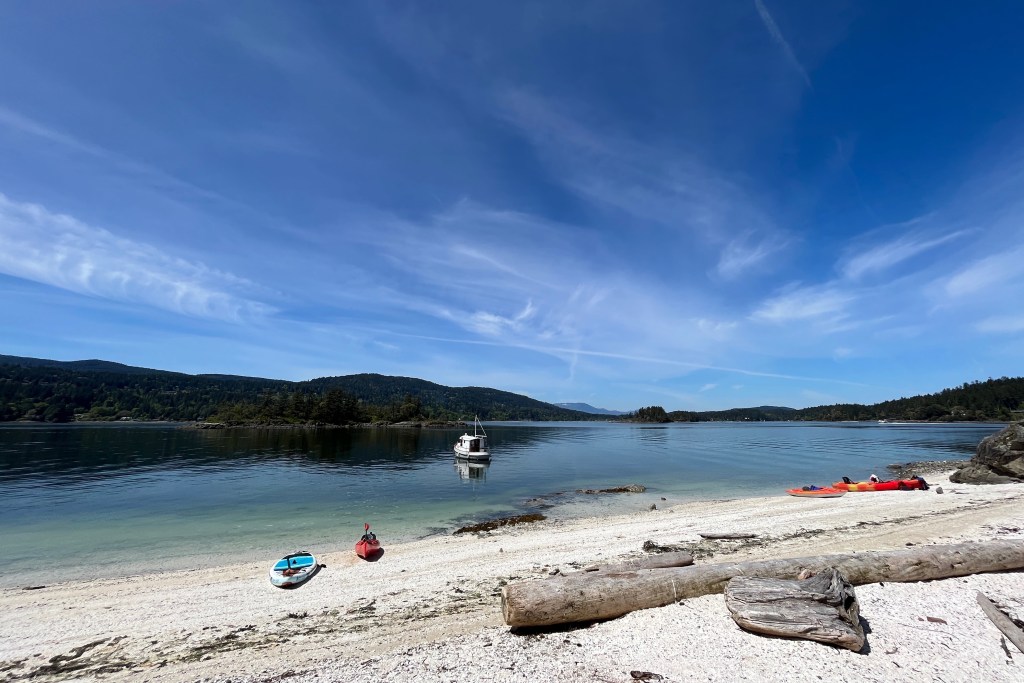
As we glide into the small bay at Russell Island, now part of the Gulf Islands National Park Reserve, Maria’s home reveals itself almost immediately. Our ‘docked’ water vessels are practically on her front yard, a sandy beach where seafood barbeques and Hawaiian luaus once filled the evening air. Apparently the home hasn’t changed much since it was built in 1906, except now it seems to vie for attention amongst the remnants of orchards and untamed gardens. A lone chair occupies the front verandah, a carved wooden sculpture draped in seashells pays homage to Maria’s Hawaiian roots, and unfortunately it isn’t apple season or we’d be welcome to pluck on or two from the orchard.
In 1901, Maria Mahoi was identified as the sole heir of Russell Island in the will of William Haumea, also of Hawaiian descent. Haumea had never built on Russel but cleared fields, establishing an orchard and a strawberry field. In 1902, Maria moved to the Island with her second husband, where not only more were children added to the growing family, but also sheep, cows and chickens. Today, descendants of Maria speak of her love of the island, her prowess as a sailor and the love of the water, her enormous strength in character and resilience. And perhaps most of all, a woman of mixed race who though at the time found herself outside of the boundaries of colonial acceptability, built a rich and proud life for her thirteen children. Maria – who refused to take a husband’s last name – is just one of many stories of our intrepid women settlers in British Columbia. Somehow standing in Maria’s garden is like a comforting, soulful whisper which stays with you as you traverse the Haumea Trail which offers beautiful views outwards. If you visit during the summer months, a volunteer host in collaboration with Maria Mahoi’s descendants, will be present share family stories that bring Maria back to life. We happily spend far more time than we anticipate and as we paddle away, I know we’ve experienced a truly special place.
Back on the big island, just across the bay where Maria often rowed to church, St. Paul’s Catholic Church reveals more of the island’s stories. After all, as the author Jean Barman in her interesting book Maria Mahoi of the Islands muses, “Maia’s story argues that, yes, our stories do matter. Her life, like everyone’s is usefully conceived as a pebble. Once thrown in the water, its waves spread out to family and community. The ripples from the pebble that was Maria continue to expand outward.”





